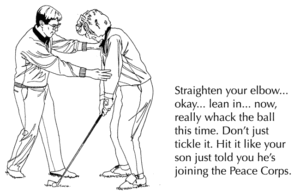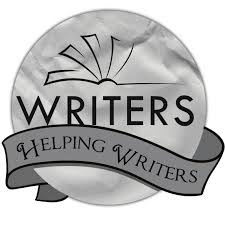Write a Novel in 18 Holes–Writers Helping Writers
A few years ago I published a book entitled How To Write A Novel in 100 Days. Now I thought I might attempt to tighten that frame of reference (and time) and focus on, How To Write a Book in 18 Holes. Over my writing career, I have published three novels on golf and edited three books of golf instruction. Now I have some advice on how to do both for anyone who writes or plays golf, or both, like myself.
Write a Novel in 18 Holes
In my mind, playing golf and writing a novel are curiously connected. Each is achieved by determination, dedication and singleness of purpose.
While most golfers play for fun in foursomes, those who want to develop their game, play alone, often early in the day or late in the evening when it is cool and quiet and the course is empty. As golfers know, if one wants to “work on their game” it’s best to do so without the distractions of others.
The same is true for novelists.
Writers seek quiet places to work. A comfortable room with a blank sheet of paper, whether it is a computer screen or a yellow legal pad where one can write and rewrite until the prose reads just right.
Golfers and novelists both face challenges of their own.
For a golfer standing on the first tee the demand is immediate:
- Keep it straight.
- Keep it out of trouble.
- Hit it hard.
A novelist task is:
- Grab the readers with the opening sentence.
- Fascinate them with a compelling plot.
- Write a page turner.
Daily Life
Besides creating a novel, the writer needs to manage a schedule and the demands of life, from family to a job. A routine is important because over the course of crafting a book one gets discouraged, bored, angry, or just fed up. A routine keeps a writer writing. One way to realize that is by writing 500 words a day for a year, they’ll then have a novel’s length of pages. But can 500 words a day be written—day in and day out–for 365 days?
This is true as well for golfers. Like everyone in the working world, somedays a player is on their game, other days it is hard to just get around the course. But a player know one thing. A single great shot will bring anyone back to play another round. And a novelist knows that to pen what Hemingway called, “one true sentence” will keep a writer writing.
What players and writers both need in their quest is help and encouragement. For players, that means lessons from a golf professional, or friendly advice from playing partners. Writers are wise to join a writing group, take classes in creative writing, and read great books to see how great writers wrote them.
Reading the Green
Half of the game of golf is played with a putter on greens where another set of skills and talent are required. Here the ability to read distance and see slopes mean the difference between a birdie and a bogey. To play well a golfer wants to understand green speed and grain, and have a masterful putting stroke. As the famous golfer Bobby Locke phrased it, “You drive for show, but putt for dough.”
Writers with a talent for ingenious plots must also create on paper characters that are compelling. Novelists need to write deft descriptions and engaging dialogue. The success of any novel comes in bringing the ingenious story to life through the character’s development by descriptions and prose. Words that sings on the page.
Playing out of Trouble
Golf is a game of hazards, bunkers, water, deep roughs, unplayable lies, trees and out-of-bounds. Players learn to navigate these perils by playing the percentages when they pull a club from the bag, or judge the distance and direction. As all golfers know, “it’s better to be safe than sorry.”
Novelists do the opposite. The secret of a successful novel is to write chapters that develop a puzzle, raise a question or problems, creates a crisis, and metaphorically speaking paint the characters into a corner where the reader is compelled to turn the page just to know “what happens next!”
Terrain and Tools
The architecture of golf courses has changed as much as the equipment. Courses have evolved from Scottish links to tight fairway layouts sandwiched between suburban towns, large developments with McMansions facing fairways and greens. The clubs have gone from hickory shafts to graphite; from persimmon woods to Big Berthas and X2 drivers. Writing novels, today, also have changed because of technology. We write not in longhand on yellow pads, or on typewriters, but by computers. And books are read in bits and pieces on Kindles, iphones, and tablets.
Commercial novels are crafted in short chapters with fast paced plots that speed the reader to The End. Reading is like playing a par-3 Executive Course, one of those short nine-hole layouts that can be played in the evening by businessmen on their way home from work.
Today, few readers tolerate the luxury of language, long descriptions, endless details, and intense character development. The days of Dickens epics are long gone in the commercial market. Golf, like the written word, has changed with the times. PGA pros are under a clock in tournaments; public course golfers are told to keep up with the foursome ahead.
Making the Turn
We’re in the middle of the round, in the middle of the novel. What now? For golfers, that means having played nine. With writers, it’s the turning point of the plot. The novel is coming together for the climax.
It is seldom simple for writers. Often a novelist will by the middle of the book introduced a new characters or developing a surprising subplot. It is time to pause, put away the pages for a few weeks and rethink the story. Often a book’s story is written when a novelist is away from the page and obsessing about the manuscript.
A golfer, taking a break at the halfway house, might contemplate that he or she is two down or several strokes over par, and decide to forgo distance for accuracy, leave the driver in the bag and play a utility wood off the tee to keep the ball in the fairway.
Fairways, Greens, and Narratives
Players have the advantage of 18 defined holes to determine a round. Finishing a novel is less directed. A book has no set pages or words to count.
For a golfer the complex geography of the course, the intertwining of fairways and rough in a zigzag pattern, dotted by bunkers and water hazards, suggest a thickly plotted narrative leading to a climax for the player perhaps not on the final hole, but a story told inside the country club’s 19th hole over a round of drinks that will be dissected and judged much like a good novel.
A novelist might have developed a plot with as many hazards and intertwinements as any golf course, but a writers can’t zigzag the narrative as if it were the geography of a country club. The story needs to be shot like an arrow at a target, the way a player hopes to drive the ball down the fairway.
Finale
Coming up the final fairway, with the club house in view, and the front terrace crowded with a gallery of members and guests, friends and family, the player just wants to finish strong. A chip that checks up for a tap-in. One last great shot in sight of the club house gallery to finish the round says it all.
The same is true for writers. He or she wants the reader to turn that last page and close the book feeling a wave of emotion. It could be sadness, or it could be satisfaction—that doesn’t matter. What matters is that the novelist wants this book to bring the reader back for the next one. The golfer’s successful last shot will also bring the player back to play another day. That’s all that matters. A writer needs to write. A golfer needs to play. And both have their own course to play.
End of the Round
End of the Story

I was a caddy as a boy (my brothers Dave and Pete also) at Brookhollow Golf Course off Harry Hines Boulevard in Dallas, Texas after we’d moved in 1948 from Niagara Falls, NY through gradeschool, highschool, even college from time to time. Tried golf a few times and was surprised at how poorly I did (after years of disparaging the golfers to the other caddies as they also did, but some of them could play golf it turned out). I hope you have a soft spot for caddies who cavil.
Ed, my three golf novels are entitled: The Caddie Who Knew Ben Hogan; The Caddie Who Played with Hickory; The Caddie Who Won the Masters.
I started caddying when I was 10 and at 16 I was the caddie master at Midlothian Country Club in Illinois. (The best job I ever had.) I did my final ‘loop’ just before going into Air Force Basic Training the summer after I graduated from college. After that it was the Peace Corps and years away from the links. I haven’t caddied since. Too old now to carry double for 18.